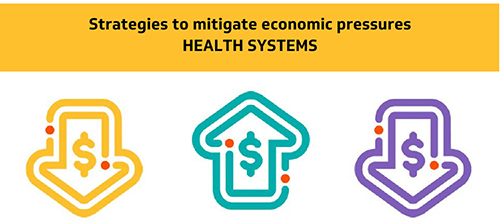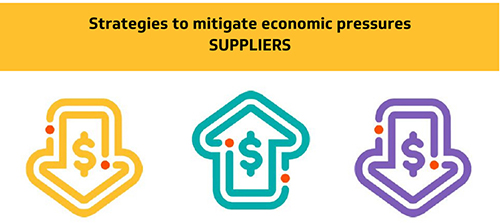
by Jeffrey Moser
Anyone who has visited Colorado and driven down from the mountains toward Denver will recognize the title of this article. The same words of caution apply to the healthcare ecosystem moving into 2023. Despite the tricky financial gradient healthcare organizations have navigated since the onset of the pandemic, the road ahead remains challenging.
Let’s break down some of the financial forces at work and a few core strategies for health systems and life science and industry partners that may mitigate the negative economic environment’s impact.
Macro-economic market pressures
High inflation is driving up health systems’ expenses and eroding margins. This financial picture compromises access to capital and thus, liquidity — particularly for organizations with low credit ratings, given the difficulty issuing new bonds and default risk on current bond covenants. The strain is widely felt in operations. A recent Becker’s Hospital Review article highlighted the measurable impact on days cash on hand. According to the article, one 140-hospital system based in Chicago saw a 30% decline from 245 days cash on hand at the 2021 fiscal year’s end June 30, and 176 days for 2022.
Smaller health systems also are seeing a decline in days cash on hand. This is particularly concerning given S&P Global states that health organizations need 260 days to achieve an “A” rating. The median Kaufman Hall Year-To-Date (YTD) Operating Margin Index reflecting actual margins was -0.1% in September, where S&P global suggests 2.6% or greater for maintaining an “A” rating.
Inflation not only impacts hospitals’ labor and supply expenses, but also squeezes the critical stakeholders that organizations count on for financial sustainability, including:
► Consumers
Although most consumers are shielded from the prices of individual services, the influx of high-deductible health plans for those with commercial coverage has heightened price sensitivity. This can dampen demand for services, particularly elective procedures. Sg2’s Impact of Change Forecast projects declines for both inpatient and outpatient price sensitive services (inpatient and outpatient respective growth rates for price sensitive services are -4% and -6% from 2022 – 2032).
► Suppliers
Inflationary pressures are not limited to U.S. markets. Globally, suppliers are shouldering increased costs of the raw goods and materials necessary for the manufacturing of their products. They too are confronting extreme wage inflation. Given their own margin pressure, price adjustments are accelerating.
Financial leaders say the U.S. economy is not in a recession … yet. If one does emerge next year, it likely will create further challenges for the healthcare industry such as:
- Payer mix erosion due to rising unemployment
- Decreased healthcare utilization
- Rising employer activism to reduce healthcare costs
- Growth in Medicare Advantage as seniors seek less costly alternatives to FFS Medicare

- Revisit flexible staffing models by scrutinizing overtime usage, worker hour per unit of service compliance, and process redesign leading to top of license and labor efficiency.
- Evaluate network integrity and implement strategies to reduce outmigration, especially related to surgical cases.
- Assess the portfolio of service and consider redistribution of services or exiting certain services where appropriate.
- Implement rolling budget and capital approval committees and consider tighter thresholds.
- Seek ways to automate (via AI) or outsource discrete labor functions to offset costs and redirect capital for clinical staff support.
- Ensure timely communication across the organization on big-impact decisions that may affect patients and providers.
- Explore strategic partnerships to realize sustainable cost-savings benefits, growth and improved outcomes.

- Educate business development/sales and marketing/market access teams on how customers define value. Recraft messaging to demonstrate partnership opportunities to assist in mitigating pain points.
- Be transparent and help customers with alternative (even competitors’) products where supply shortages may exist.
- Recognize that employer efforts to develop narrow networks or partner in high-cost areas present opportunities to engage in value-based agreements with health systems, insurance providers, or directly with large employers or consortia.
- Leverage data capabilities and value solutions to help providers identify opportunities for improvement in outcomes, variation and total cost of care.
Micro-economic pressures
There are numerous micro-economic pressures that are plaguing health systems, including:
► Volumes
Hospital volumes — particularly emergency department and inpatient surgical volumes — have not fully rebounded since the onset of the pandemic. Excluding COVID-19 diagnoses, overall inpatient utilization remains 9% below pre-pandemic levels. Likewise, non-COVID ED volume is down 3% and inpatient surgical volume is down 11% between Q2 2019 and Q2 2022. Though volume has not fully recovered, length of stay and patient acuity (as measured by Case Mix Index) continues to rise. Both LOS and CMI are up 8% and 5% respectively from Q2 2019 – Q2 2022.
► Capacity
Workforce constraints have forced bed closures in some hospitals, further compromising revenue growth. Even beyond difficulty accessing capital, staffing shortages also have delayed or quashed countless building plans or even deployment of digital health capabilities.
► Payer mix
Commercial coverage is a diminishing portion of most systems’ payer portfolios, and its generous rate structure also is under pressure. Payment rates in commercial contracts as a percent of Medicare vary widely nationwide, with some health systems seeing little upside and others garnering as high as 189%. In states on the high end, such as Indiana, employers have ratcheted up efforts to drive down their costs of employee benefits, with a growing contingent calling for government intervention. Employers, both large and small, view healthcare as a core expense they have limited ability to influence. But in an environment with historically low unemployment, they are hesitant to trim benefits viewed as key to their ability to attract talent.
Continued growth in Medicare has shifted more volumes into a reimbursement structure under which few organizations have been able to generate a positive margin. Simultaneously, surging uptake of Medicare Advantage plans, expected to reach 50% of the Medicare population by 2030, dampens utilization given the care management mechanisms that curb use of high-cost, often hospital-based, services or sites.
Though historically not a margin driver for health systems, expanded Medicaid enrollment during COVID-19 was substantial. As the COVID-19 Public Health Emergency (PHE) unwinds, likely in 2023, states will need to review their Medicaid rolls as significant numbers of individuals may no longer be eligible. Despite efforts by state Medicaid programs, Marketplace Navigators and employers to help current Medicaid enrollees retain coverage after the PHE, a portion will transfer to uninsured status, which will pressure systems who continue to provide care to those individuals.
► Expense Pressures
Labor represents roughly half of most organizations’ expense base. Use of contract labor soared during the pandemic, but recent trends suggest a slowdown. A potential recession may lead additional nurses to forgo travel gigs in favor of the stability of employment. Although travel nurse use proved transient, roughly two-thirds of organizations boosted wages for employed clinical staff 11% or more in the past year to compete for talent. These increases are now baked into organizations’ cost structures. Wage pressure, albeit not as great, also is being felt for support services like environmental services and information technology.
Supply expenses are also up year over year, with roughly 50% reporting increases of 11% or more. Expense increase is coupled with supply chain disruptions that impact the ability of providers to deliver necessary care.
Though 2023 promises to be challenging, health systems and suppliers can traverse this rocky road by fully understanding the obstacles ahead — and implementing strategies to minimize them.
Tags: consumer, health care disruption, health care ecosystem, health care landscape, health systems, hospital volumes, life sciences, life sciences and industry, payer mix, supplier



